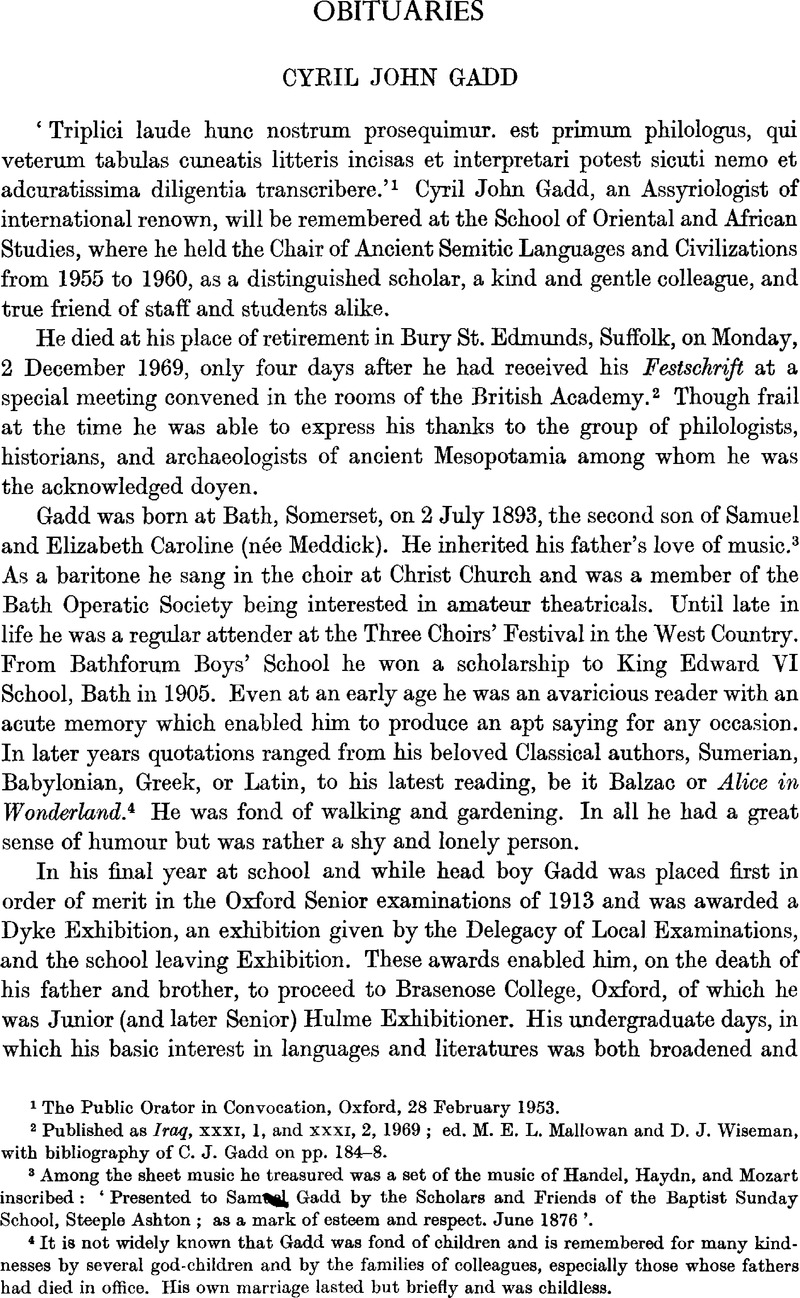No CrossRef data available.
Article contents
Abstract

- Type
- Obituaries
- Information
- Bulletin of the School of Oriental and African Studies , Volume 33 , Issue 3 , October 1970 , pp. 593 - 598
- Copyright
- Copyright © School of Oriental and African Studies 1970
References
2 Published asIraq, xxxi, 1, and xxxi, 2, 1969Google Scholar; ed. M. E. L. Mallowan and D. J. Wiseman, with bibliography of C. J. Gadd on pp. 184–8.
3 Among the sheet music he treasured was a set of the music of Handel, Haydn, and Mozart inscribed: ‘Presented to Samuel Gadd by the Scholars and Friends of the Baptist Sunday School, Steeple Ashton; as a mark of esteem and respect. June 1876 ’.
4 It is not widely known that Gadd was fond of children and is remembered for many kindnesses by several god-children and by the families of colleagues, especially those whose fathers had died in office. His own marriage lasted but briefly and was childless.
5 As reflected in his diaries which go into some detail of the siting of sheerlegs for the mechanical excavation of the well of Aššur-nasir-apli II and the building of a field oven for firing tablets at Nimrud in 1952. During his Keepership he brought into use a special laboratory for treating clay tablets.
6 Cuneiform texts from Babylonian tablets etc., in the British Museum (hereafter GT), xxxvi, 1921Google Scholar; The early dynasties of Sumer and Akkad, 1921.
7 He later introduced the current system of cataloguing and planned the series Catalogue of the Babylonian tablets in the British Museum.
8 The fall of Nineveh: the newly discovered chronicle no. 21901, British Museum, 1923.
9 Punch, 18 July 1923, 50, ‘On the inst??lity of things' by 0. S. (Sir Owen Seaman). Reprinted by permission of Punch.
10 He read a paper on ‘The Sumerian after-life’ at the Society's Jubilee meeting on 4 January 1950.
11 His photographic albums and diaries for this journey to Ur (where he was from 2 October 1923 to 14 March 1924), as for subsequent missions on behalf of the British Museum to the Museum of the Ancient East, Istanbul (1933); the ‘Atshānah expedition in 1946; and to Nimrud, Iraq (1952) are now in the British Museum.
12 Gadd, C. J., Times, 19 03 1966Google Scholar, in a leading article on ‘Nimrud reveals its treasures’ cf. his article on ‘Layard at Nineveh’, Times, 9 November 1945,. He was a reviewer for the Times Literary Supplement, 1921–37.
13 Diary, ad. loc. To his mother he wrote ‘I've had the luck to find the oldest dated historical document from this land’ (letter of 1 December 1923).
14 The Public Orator in Convocation, Oxford, 28 February 1953: ‘et quo putatis eum animo fuisse turn cum in eo loco, quern trium primum nominavi, hortante archaeologo primario, Leonardo Woolley, verba legeret lapidi insculpta quae non modo parietinarum aotatem ostenderent, sed regiae domus annales, rem diu ab historicis agitatam, ad certam temporum rationem perducerent’. Cf. SirWoolley, Leonard, Ur of the Chaldees, 1938, 53Google Scholar: ‘A workman unearthed before my eyes a small oblong tablet of white limestone bearing an inscription. I handed it to Mr. Gadd,…and he read it out…’. It ‘not only proved the date of the building but cleared up a whole chapter in ancient history ’.
15 History and monuments of Ur, 1929. A reviewer of this book must surely have noted the echoes in Gadd's style culled from his favourite Edward Gibbon, The decline and fall of the Roman Empire, for he wrote, ‘…Gadd on men of Ur is likely to be nearer the actual truth than Gibbon and Mommsen on Rome!’ (New Statesman, 28 September 1929).
16 ‘Early Sumerian sculpture’, BMQ, I, 2, 1926, 38–40Google Scholar; articles on cylinder seals in BMQ, III, 2, 1928, 39–40, v, 3, 1930, 97–8Google Scholar; and especially his ‘Seals of ancient Indian style found at Ur’, Proc. British Academy, XVIII, 1932, 191–210Google Scholar.
17 Also The Assyrian sculptures, 1934; Assyrian sculptures in the British Museum, from Shalmaneser III to Sennacherib, 1938.
18 ‘Tablets from Kirkuk’, RA, xxiii, 1926, 49–161Google Scholar.
19 His diary shows that for him the highlight of his stay there was the pipe-playing of the local shepherds.
20 CT, xxxviii, 1925Google Scholar; xxxix, 1926; XL, 1927; XLI, 1931. He had as his first task to check and revise for publication in 1920 a volume of lexical and historical texts (CT, xxxv) copied by A. W. A. Leeper.
21 ‘Tablets from Chagar Bazar and Tall Brak, 1937–38’, Iraq, vii, 3, 1940, 22–66Google Scholar. Despite wartime restrictions Gadd saw to press two supplements in 1943 and 1944; regular publication was renewed in 1946.
22 He also served on the Council of Management of the British Institute of Archaeology at Ankara, 1950–65.
23 e.g. Hall, H. R., Ancient history of the Near East, eighth ed., 1932Google Scholar, revised by C. J. O.
24 A dictionary of Assyrian botany, British Academy, 1949.
25 Teachers and students in the oldest schools (inaugural lecture, School of Oriental and African Studies, 6 March 1956).
26 ‘The Harran inscriptions of Nabonidus’, Anatolian Studies, VIII, 1958, 35–92Google Scholar.
27 Among notable addresses he delivered in French was one at the centenary of the foundation of the Département assyrien du Musée du Louvre, Paris, in June 1947 as representative of the Trustees of the British Museum. He gave two public lectures at the Université de Genève in 1954.




